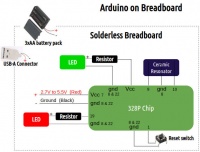Minimalist Arduino: Difference between revisions
Jump to navigation
Jump to search
No edit summary |
|||
| (7 intermediate revisions by 2 users not shown) | |||
| Line 1: | Line 1: | ||
{|style="float:right;border:1px solid black" | |||
| {{Infobox | |||
|name = Infobox | |||
|bodystyle = | |||
|title = Minimalist Arduino | |||
|titlestyle = | |||
= | |image = [[File:minarduino.jpg|200px|alt=Example alt text]] | ||
|imagestyle = | |||
|caption = Short description | |||
|captionstyle = | |||
|headerstyle = background:#ccf; | |||
|labelstyle = background:#ddf; | |||
|datastyle = | |||
= | |header1 = Specifications | ||
|label1 = dfd | |||
|data1 = dfd | |||
|header2 = | |||
|label2 = Product Ecology | |||
|data2 = What other GVCS tools does this use? | |||
|header3 = | |||
|label3 = License | |||
|data3 = [[OSHWA]] and [[OSI]] compliant. CC-BY-SA-4.0 International, GPLv3, [[DIN SPEC 3105]]. | |||
|header4 = | |||
|label4 = Module 1 | |||
|data4 = Describe features of Module 1 | |||
|header5 = | |||
|label5 = Module 2 | |||
|data5 = Describe features of Module 2 | |||
|header6 = | |||
|label6 = Key Specification | |||
|data6 = Key spec data point | |||
|header7 = | |||
|label7 = Construction | |||
|data7 = Describe basic construction technique and materials | |||
|header8 = | |||
|label8 = Productivity | |||
|data8 = Describe how this relates to industrial productivity on a small scale | |||
|header9 = Completion Status | |||
|label9 = | |||
|data9 = | |||
|header10 = | |||
|label10 = | |||
|data10 = Describe whether built, prototyped, etc. Link to relevant [[Genealogy]] and [[Status of Completion]]. | |||
= | |belowstyle = background:#ddf; | ||
|below = Do you want more of this? [[Get Involved]] | |||
}} | |||
|} | |||
=Development= | |||
{| class="wikitable" | |||
|+ Development Template | |||
! | |||
! Description | |||
! Link to Work Product | |||
! % | |||
|- | |||
! scope=row | | |||
| '''DESIGN''' || || | |||
|- | |||
! scope=row | 1 | |||
| [[Requirements + Value Proposition]] || [[Minimalist Arduino Requirements + Value Proposition]] || 0 | |||
= | |- | ||
! scope=row | 2 | |||
| [[Industry_Standards]] || [[Minimalist Arduino Industry Standards]] || 0 | |||
|- | |||
! scope=row | 3 | |||
| [[Conceptual Design]] || [[Minimalist Arduino Conceptual Design]] || 0 | |||
|- | |||
! scope=row | 4 | |||
| [[Module Breakdown]] || [[Minimalist Arduino Module Breakdown]] || 0 | |||
= | |- | ||
[[ | ! scope=row | 5 | ||
| [[3D CAD]] || [[Minimalist Arduino 3D CAD]] || 0 | |||
|- | |||
! scope=row | 6 | |||
| [[Basic Calculations|Calculations]] || [[Minimalist Arduino Calculations]] || 0 | |||
= | |- | ||
! scope=row | 7 | |||
| [[Electronics Design]] || [[Minimalist Arduino Electronics Design]] || 0 | |||
|- | |||
! scope=row | 8 | |||
| [[Wiring and Plumbing]] || [[Minimalist Arduino Wiring and Plumbing]] || 0 | |||
|- | |||
! scope=row | 9 | |||
| [[Software]] || [[Minimalist Arduino Software]] || 0 | |||
|- | |||
! scope=row | | |||
| '''BILL OF MATERIALS || || | |||
|- | |||
! scope=row | 10 | |||
| [[Proper BOM|BOM]] || [[Minimalist Arduino BOM]] || 0 | |||
|- | |||
! scope=row | 11 | |||
| [[vBOM]] || [[Minimalist Arduino vBOM]] || 0 | |||
|- | |||
! scope=row | 12 | |||
| [[CAM Files]] || [[Minimalist Arduino CAM Files]] || 0 | |||
|- | |||
! scope=row | 13 | |||
| [[Cut List]] || [[Minimalist Arduino Cut List]] || 0 | |||
|- | |||
! scope=row | | |||
| '''BUILD''' || || | |||
|- | |||
! scope=row | 14 | |||
| [[Build Instructions]] || [[Minimalist Arduino Build Instructions]] || 0 | |||
|- | |||
! scope=row | 15 | |||
| [[Fabrication Drawings]] || [[Minimalist Arduino Fabrication Drawings]] || 0 | |||
|- | |||
! scope=row | 16 | |||
| [[Exploded Part Diagram]] || [[Minimalist Arduino Exploded Part Diagram]] || 0 | |||
|- | |||
! scope=row | 17 | |||
| [[Production Engineering]] || [[Minimalist Arduino Production Engineering]] || 0 | |||
|- | |||
! scope=row | | |||
| '''LIFECYCLE DESIGN''' || || | |||
|- | |||
! scope=row | 18 | |||
| [[Build Pictures and Video]] || [[Minimalist Arduino Build Pictures and Video]] || 0 | |||
|- | |||
! scope=row | 19 | |||
| [[Data Collection]] || [[Minimalist Arduino Data Collection]] || 0 | |||
|- | |||
! scope=row | 20 | |||
| [[Future Work]] || [[Minimalist Arduino Future Work]] || 0 | |||
|- | |||
! scope=row | 21 | |||
| [[Troubleshooting and Repair]] || [[Minimalist Arduino Troubleshooting and Repair]] || 0 | |||
|} | |||
=Links= | =Links= | ||
*[[ | *[[Minimalist Arduino Log]] | ||
Latest revision as of 01:45, 5 September 2020
| ||||||||||||||||||||||||||
